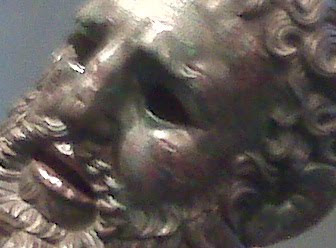 "[T]he Seated Boxer; an extraordinary bronze found near the Baths of Constantine on the Quirinal hill. His body slumps forward; his forearms ret on his thighs; his hands hang limp, pulled down by the weight of studded leather wrappings. His upturned face, cut and swollen, looks for a victory he does not expect.
"[T]he Seated Boxer; an extraordinary bronze found near the Baths of Constantine on the Quirinal hill. His body slumps forward; his forearms ret on his thighs; his hands hang limp, pulled down by the weight of studded leather wrappings. His upturned face, cut and swollen, looks for a victory he does not expect."The Romans were fascinated by suffering, its representation in art and its recreation in the theater and amphitheater. They admired professional fighters like this boxer and the gladiators in the Colosseum. The writer Tertullian, who as a Christian was no stranger to the mystery of suffering, found the Roman fascination with such men paradoxical. "Men give them their souls, women their bodies...On one and the same account they glorify them and despise them, openly condemning them to ignominy and the loss of civil rights. The perversity of it! Yet they love those they punish and belittle those they admire." (De spectaculis 22). Such strong feelings suggest a sense of identification with the gladiator or the boxer, a feeling that apparently grew stronger as the Empire aged. As the empire monopolized power, individuals may have felt deprived of the same civil rights that gladiators were forced to abjure. And in the Seated Boxer's ability to endure pain, to survive or to die with equanimity and dignity, they mayh have found a terrible model of their own fate."
 Text lifted wholesale from the best tour guide to Rome I've ever seen: James H.S. McGregor, Rome From the Ground Up 103-104 (2005, 2006). McGregor says that the Boxer is in the Aula Ottagona; he has been moved to the Palazzo Massimo alle Terme, and h/t to Steve for insisting that I seek out this superb museum, hitherto unnoticed by me.
Text lifted wholesale from the best tour guide to Rome I've ever seen: James H.S. McGregor, Rome From the Ground Up 103-104 (2005, 2006). McGregor says that the Boxer is in the Aula Ottagona; he has been moved to the Palazzo Massimo alle Terme, and h/t to Steve for insisting that I seek out this superb museum, hitherto unnoticed by me.fn: I see that McGregor also has books on Venice, Washington, and Paris
No comments:
Post a Comment